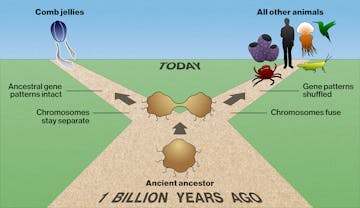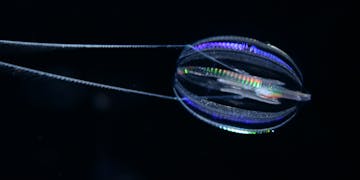The ocean’s depths remain shrouded in mystery, but MBARI technology is helping scientists answer fundamental questions about the ocean and its inhabitants. As our team explores the waters of Monterey Bay and beyond, we are improving our understanding of the largest environment on Earth.
Specialized equipment on MBARI’s robotic submersibles allows researchers to gently collect deep-sea animals for further study in the laboratory. On shore, we can closely examine an animal’s appearance, but more importantly, investigate its genetic material, which contains a world of secrets.
Understanding what species live in the ocean’s depths is critical to understanding deep-sea ecosystems, how they are linked, and how they might be changing. The DNA “fingerprints” of marine life are transforming our ability to take a census of the deep sea. But studying the genetics of deep-sea organisms is also shedding new light on fundamental questions about life on Earth.

Comb jellies, also known as ctenophores, are a notoriously challenging group to study. MBARI’s Biodiversity and Biooptics Team has developed unique tools for collecting these delicate drifters. They have sequenced the genomes of several deep-sea comb jellies and uncovered important clues about evolutionary events in the transition from single-celled organisms to multicellular animals.
More than 700 million years ago, different groups of small organisms split off the tree of life to evolve along their own independent paths, becoming the animals we know today. Scientists have long sought to understand this pivotal moment in animal evolution. As technology and science have advanced, scientists have investigated two alternative hypotheses for which animals—sponges or comb jellies—were most distantly related to all other animals.
For more than a century, researchers assumed that sponges split off the tree of life hundreds of millions of years ago making them the sibling group to all other animals. However, 15 years ago, researchers were able to use new DNA-sequencing methods to find the first evidence that ctenophores, not sponges, might be the sibling group of all other animals. This research sparked a great effort by the scientific community to develop new ways to confirm the identity of the oldest branch of the animal family tree, but a definitive answer remained unclear.
“We’ve used genetics to travel back in time and answer a fundamental question about the earliest events in animal evolution.”
—Former Graduate Student Researcher Darrin Schultz
Identifying this outlier—known as the sibling group—has long eluded scientists. New work by a team of researchers from MBARI, the University of California, Berkeley, the University of California, Santa Cruz, and the University of Vienna has provided valuable new insight into this question.
All of the genes in an animal are organized in sequences on chromosomes. The location of an individual gene sequence can change over time, but changes to the sets of genes found together on a particular chromosome are rare and largely irreversible.
Until now, scientists have only looked at the similarities in the sequences of genes—similar to comparing the spelling of words—to answer long-standing questions about the most ancient animal relationships. However, this technique did not give reliable answers about whether sponges or ctenophores were the sibling group of all other animals. MBARI researchers and their collaborators took a new approach: They mapped sets of genes that are always found together on a single chromosome, in everything from humans and hamsters to crabs and corals.

While groups of animals have evolved hundreds of millions of years apart, a remarkably large number of genes remain linked to the same chromosomes across these vastly different groups. Over time, the sequence of genes on each chromosome may change, but the particular chromosome where they are located remains the same, except for in rare circumstances.
MBARI researchers used the novel chromosome-mapping technique to find clues in the genomes of comb jellies, sponges, and even single-celled non-animals.
First, the team sequenced the genomes for the entire length of each chromosome for two comb jellies and two marine sponges as well as three single-celled close relatives of animals—a choanoflagellate, a filasterean amoeba, and an ichthyosporean—in order to create a more complete picture of each one’s gene organization.
With the complete chromosome sequences in hand, MBARI researchers looked for patterns of linked genes to help answer the question of whether sponges or ctenophores are the most distant relative of all other animals.
Because links between genes and chromosome location change relatively slowly, these changes reveal how ancient genomes may have been arranged. When researchers examined the chromosome-scale genome of comb jellies, they saw a grouping of genes that was very different from the patterns in other animals. Most importantly, they found patterns of genes that were shared between the ctenophores and the three single-celled non-animals, whereas those patterns had been shuffled and mixed in all other animals, from sponges to sparrows.
Comparing specific patterns of linked genes allowed researchers to build a deeply-rooted tree of animal life and better establish the order in which branches split off from the main trunk. Mapping gene linkages back to the earliest point in animal evolution, the team found strong evidence that comb jellies represent a unique lineage whose ancestors diverged before the common ancestor of all other animals.

Analyzing patterns of linked genes revealed that comb jellies represent a lineage whose ancestors split into their own group, separate from all other animals, approximately 700 million years ago. Illustration: Madeline Go © 2023 MBARI
The team compares this event to a genetic fork in the road of evolution that happened hundreds of millions of years ago. A lone single-celled organism, the ancestor of all animals, was traveling along that road with its two offspring. One child, which would evolve into comb jellies as we know them today, took one path. As it evolved, some of its genes stayed on the same chromosomes. The other child, which would evolve into sponges and all other animals as we know them today, took the other path. Many of its chromosomes were shuffled and fused together. Because these rearrangements are nearly always irreversible and passed down generation to generation, they are detectable even today. By tracking these rearrangements, the team found clear-cut evidence that comb jellies, not sponges, are the sibling group to all other animals.

The fingerprints of this ancient evolutionary event are still present in the genomes of animals hundreds of millions of years later, providing clues to which ancient organism gave rise to the diverse array of animals in the world today.
Understanding the relationships among animals will help shape our thinking about how key features of animal anatomy, such as the nervous system or digestive tract, have evolved over time. The team’s findings will lay the foundation for the scientific community to begin to develop a better understanding of how animals—and humans—evolved. This research gives scientists new context for the defining characteristics of animal life. It will help us better understand the genetics that underpin basic functions all animals share, like how they sense their surroundings, how they eat, and how they move.
Funding for this research was provided by the David and Lucile Packard Foundation, MBARI, the National Science Foundation (GRFP DGE 1339067 and DEB-1542679), the European Research Council’s Horizon 2020: European Union Research and Innovation Programme (grant No. 945026), internal funds of the Okinawa Institute of Science and Technology Molecular Genetics Unit, the Chan Zuckerberg Biohub Network, and the Marthella Foskett Brown Chair in Biological Sciences.
Research Publication:
Schultz, D.T., S.H.D. Haddock, J.V. Bredeson, R.E. Green, O. Simakov, and D.S. Rokhsar. 2023. Ancient gene linkages show that ctenophores are sister to other animals. Nature, 618: 110-117. doi.org/10.1038/s41586-023-05936-6
